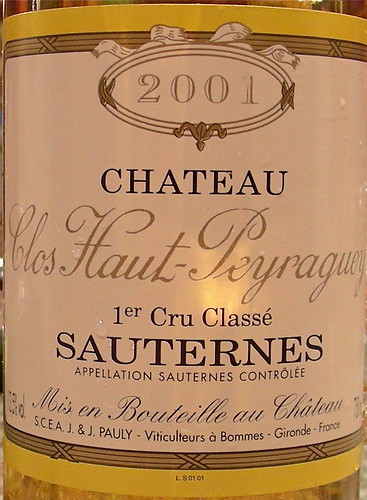
The poached foie gras tightly wrapped with plastic wrap

Slicing the foie gras
To accompany the foie gras, our friend Christophe and I had brought two different bottles of Sauternes that we enthusiastically compared side by side.
 Christophe's was the 2005 Château Doisy-Védrines from an estate vineyard dominated by the Sémillon grape (approximately 85% Sémillon, the rest planted with Sauvignon Blanc). Like in the other Sauternes Châteaux, the harvest is labor-intensive, picking the fruit in several waves called tries to select the berries most affected by the Botrytis fungus. The wine is aged for eighteen months in oak barrels, 70% of which being new. The 2005 vintage was excellent in Sauternes with lots of heat and sunshine to ripen the grapes and foggy nights and mornings to promote the development of botrytis.
Christophe's was the 2005 Château Doisy-Védrines from an estate vineyard dominated by the Sémillon grape (approximately 85% Sémillon, the rest planted with Sauvignon Blanc). Like in the other Sauternes Châteaux, the harvest is labor-intensive, picking the fruit in several waves called tries to select the berries most affected by the Botrytis fungus. The wine is aged for eighteen months in oak barrels, 70% of which being new. The 2005 vintage was excellent in Sauternes with lots of heat and sunshine to ripen the grapes and foggy nights and mornings to promote the development of botrytis.The wine had a bright color with rich aromas of dried apricot and pineapple. The palate had a lighter body with a lively acidity and a smooth and elegant finish.
 Mine was the 2001 Château Clos Haut-Peyraguey, an estate with 17 hectares under vine planted with Sémillon (90%) and Sauvignon Blanc (10%). The terroir is excellent for the appellation, characterized by north-east facing slopes and gravely and sandy soils on a clayey subsoil. The harvest is done manually in 4-7 successive tries to hand-pick the best botrytis-infected grapes. The 2001 vintage was highly rated in Sauternes, thanks to exceptional weather conditions and a speedy spread of botrytis on grapes that had the time to fully ripen.
Mine was the 2001 Château Clos Haut-Peyraguey, an estate with 17 hectares under vine planted with Sémillon (90%) and Sauvignon Blanc (10%). The terroir is excellent for the appellation, characterized by north-east facing slopes and gravely and sandy soils on a clayey subsoil. The harvest is done manually in 4-7 successive tries to hand-pick the best botrytis-infected grapes. The 2001 vintage was highly rated in Sauternes, thanks to exceptional weather conditions and a speedy spread of botrytis on grapes that had the time to fully ripen.The wine was opulent, with apricots, acacia flower, and honey aromas. On the palate, it was thicker and sweeter with a lingering finish of caramelized fruits.
So which one was the best with the foie gras: the livelier 2005 Doisy-Védrines or the more opulent 2001 Clos Haut-Peyraguey? I am sorry, I couldn't decide, they were both so good!
Technorati tags: wine food & drink
2 comments:
Many thanks for the recipe and photos!
Correction, it's not 5mn but more like 12mn!
Post a Comment